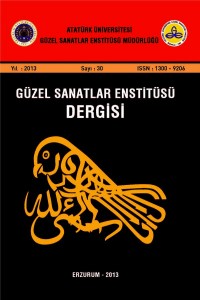Abstract
There are many castles in the Çukurova region. Most of these castles that are indispensible for military architecture were particularly built on high places such as Toros Mountains, on rocky hills. While building these castles, there were chosen hills which are difficult to reach, and sharp Rockies were used as fortification by utilizing the topographic structure of hill well. Construction material was brought from the hill itself. Maran Castle was built on such a hill that is difficult to reach, an altitude of 1410. The castle that has medieval features within its all details has longitudinal plan in the Northsouth direction like the shape of the hill that was built on it. In the available parts of hill’s east side of the castle, there established a defensive fortification by blocking the breaks of hills. The West side of it that is more available to attacks was all translated to city Wall and towers. The narrow South part of hill was fortified with towers in the aim of observation. The hill where the castle was built on, overlooks to a valley around it and it is in a dominant position of a road in its foothill as well. The castle was guarding the distance of 22 km. from Feke Castle to it besides the civil settlement in front of it. Maran Castle has similarities with Feke Castle in terms of architectural and space besides plan. The castle exhibits great similarities with garrison castles around it with its castle turrets, tanks, entrance doors, chapels, ward, well, material and pantry. In this study, the castle was defined in details, similar castles were discussed in terms of plan and architecture and the examination of assesments on castles around Çukurova with Maran Castle is reflected.
Keywords
References
- Abül-Faraç, (1950). Abül-Faraç Tarihi, C.II.(Çev. Ömer Rıza Doğrul) Ankara.
- Akpolat, S.M.(2008). “Kilikya Bölgesinde Bir Ortaçağ Askeri Mimarlık Örneği: Feke Kalesi”, Hacettepe Üniversitesi Edebiyat Fakültesi Dergisi, 25(2), Ankara.
- Buyruk, H. (2011).Sis’i(Kozan) Akdeniz’den Kapadokya’ya Bağlayan Kervan Yolu Kaleleri, Yayımlanmamış Doktora Tezi, Atatürk Üniversitesi Sosyal Bilimler Enstitüsü, Erzurum.
- Çambel, H.– Günay, R - Sabuncu, A.(2007) Kumkale Toros Eteklerinde Bir Haçlı Kalesi, İstanbul.
- Edwards, R. W. (1987). The Fortificiations of Armenian Clicia, Washington. Ersan, M. (2002). Selçuklu-Ermeni İlişkileri” Türkler Ansiklopedisi, Ankara. Gough M. (1952). “Anazarbus” (Anavarza), Anatolien Studies,2 Ankara.
- Hellenkemper, H. (1976). Burgen Der Kreuzrıtterzeit in der Grafschaft Edessa Und im Königreich Kleinarmenien, Bonn.
- Hovannisian, R.G.-Payaslian, S. (2008). Armenian Cilicia, California.
- Langlois V. (1861). Voyage Dans la Cilicie et Dans Les Montagnes Du Taurus Execute Pendant Les Annees 1852–1853, Paris.
- Runciman, S.(1986). Haçlı Seferleri Tarihi, C.I, (Çev. Fikret Işıltan), Ankara. Youngs G.R.(1965). ”There Cilician Castles”, Anatolian Studios,15, Ankara
Abstract
Çukurova Bölgesi’nde birçok kale bulunmaktadır. Askeri mimarinin
olmazsa olmazı sayılan bu kalelerin büyük bir çoğunluğu da özellikle Toros
Dağları gibi yükseklere, kayalık tepelerin üzerine inşa edilmişlerdir. Bu
kaleler inşa edilirken, ulaşılması güç tepeler tercih edilmiş, tepenin topoğrafik
yapısı iyi kullanılarak keskin kayalıklar sur duvarı gibi kullanılmıştır. Kale
inşasında malzeme kurulu bulunduğu tepenin kendisinden karşılanmıştır.
Maran Kalesi de ulaşılması hayli zor 1410 rakımlı böyle bir tepenin üzerine
inşa edilmiştir. Ortaçağ askeri yapısı özelliği gösteren kale, bulunduğu
tepenin şekline uydurularak, kuzey-güney doğrultusunda uzunlamasına bir
plan göstermektedir. Kalenin erişilmesi güç doğu tarafının sadece ulaşılmaya
müsait kısımları, kayalıkların araları sur duvarı ile örülerek bir savunma
oluşturulmuştur. Saldırıya daha açık olan batı tarafı ise tamamıyla sur duvarı
ve kulelerle çevrilmiştir. Dar olan güney ve kuzey taraflar ise hem savunma
hem de gözetleme amacıyla kuleleriyle tahkim edilmiştir. Kalenin bulunduğu
tepe, civarında uzanan geniş bir vadiye nazır olduğu gibi eteklerinden geçen
yola da hâkim konumdadır. Kale, doğu alt tarafında kurulu bulunan sivil
yerleşimin yanında Feke Kalesi ile arasında bulunan 22 km. lik mesafenin
büyük bir bölümünü de koruyordu. Plan olarak civarındaki Feke Kalesi ile
yakın benzerlikler gösteren Maran Kalesi, mekân ve mimari özellik olarak da
bu benzerlikleri tekrarlamaktadır. Kale içinde barındırdığı kule, sarnıç, giriş
kapıları, şapel, koğuş, su kuyusu, malzeme ve kiler kısımlarıyla Çukurova
Bölgesi’nde bulunan diğer garnizon kaleleriyle yakın benzerlikler
sergilemektedir. Çalışmada kale, detaylı bir şekilde tanımlanmış, plan ve
mimari yönüyle benzer kaleler tartışılmış ve Maran Kalesi üzerinden
Çukurova’daki kalelerin genel bir değerlendirilmesi yapılmıştır.
Keywords
References
- Abül-Faraç, (1950). Abül-Faraç Tarihi, C.II.(Çev. Ömer Rıza Doğrul) Ankara.
- Akpolat, S.M.(2008). “Kilikya Bölgesinde Bir Ortaçağ Askeri Mimarlık Örneği: Feke Kalesi”, Hacettepe Üniversitesi Edebiyat Fakültesi Dergisi, 25(2), Ankara.
- Buyruk, H. (2011).Sis’i(Kozan) Akdeniz’den Kapadokya’ya Bağlayan Kervan Yolu Kaleleri, Yayımlanmamış Doktora Tezi, Atatürk Üniversitesi Sosyal Bilimler Enstitüsü, Erzurum.
- Çambel, H.– Günay, R - Sabuncu, A.(2007) Kumkale Toros Eteklerinde Bir Haçlı Kalesi, İstanbul.
- Edwards, R. W. (1987). The Fortificiations of Armenian Clicia, Washington. Ersan, M. (2002). Selçuklu-Ermeni İlişkileri” Türkler Ansiklopedisi, Ankara. Gough M. (1952). “Anazarbus” (Anavarza), Anatolien Studies,2 Ankara.
- Hellenkemper, H. (1976). Burgen Der Kreuzrıtterzeit in der Grafschaft Edessa Und im Königreich Kleinarmenien, Bonn.
- Hovannisian, R.G.-Payaslian, S. (2008). Armenian Cilicia, California.
- Langlois V. (1861). Voyage Dans la Cilicie et Dans Les Montagnes Du Taurus Execute Pendant Les Annees 1852–1853, Paris.
- Runciman, S.(1986). Haçlı Seferleri Tarihi, C.I, (Çev. Fikret Işıltan), Ankara. Youngs G.R.(1965). ”There Cilician Castles”, Anatolian Studios,15, Ankara
Details
| Primary Language | tr;en |
|---|---|
| Journal Section | Articles |
| Authors | |
| Publication Date | November 19, 2013 |
| Submission Date | November 19, 2013 |
| Published in Issue | Year 2013 Issue: 30 |
Obtaining permissions for studies requiring ethics committee approval regarding the implementation of ethical rules and including information about permission in the article was added to the criteria. In this direction, Ethics Committee Permission is required for articles submitted to our journal and meeting the conditions stated below.
• Any research conducted with qualitative or quantitative approaches that require data collection from participants using questionnaires, interviews, focus group work, observation, experimentation, and interview techniques.
Also;
• Obtaining and indicating permission from the owners for the use of scales, surveys and photographs belonging to others,
• It should be stated that the copyright regulations are complied with for the intellectual and artistic works used.


